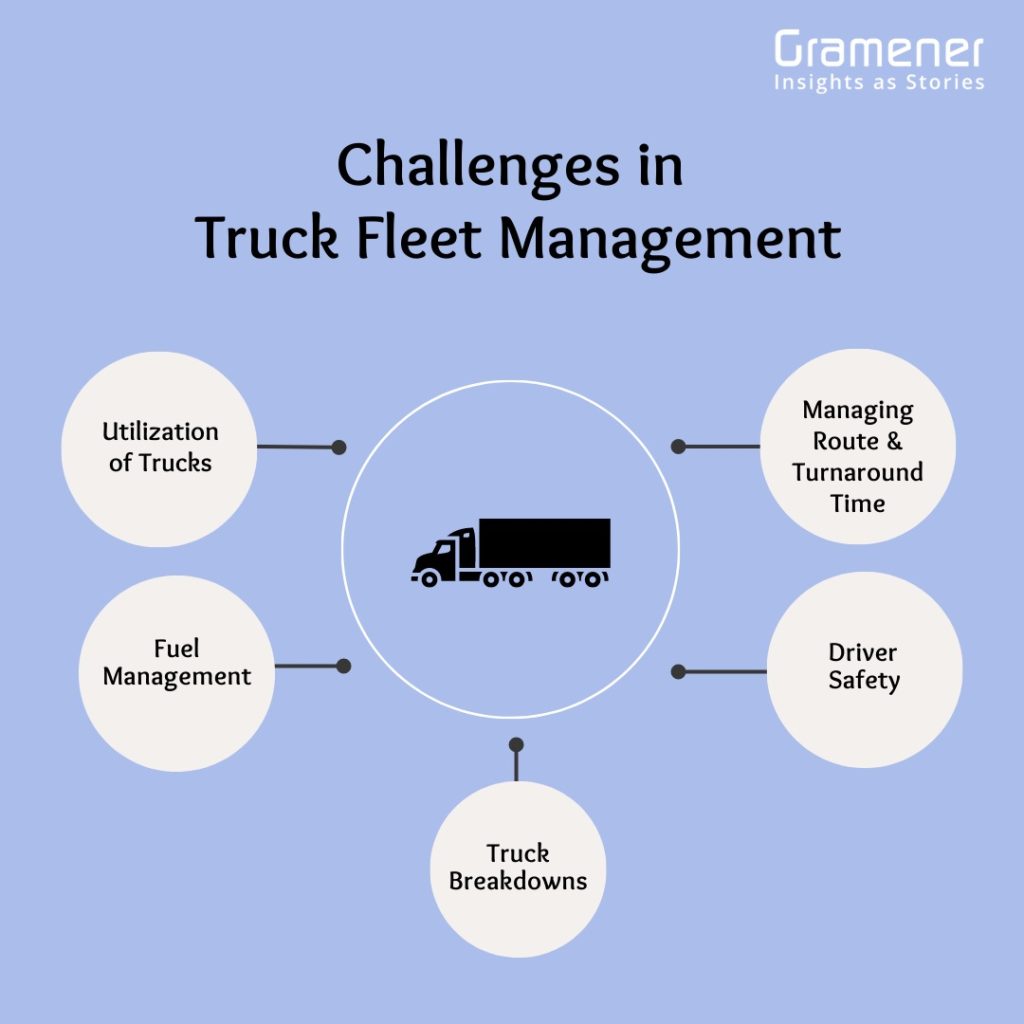From January 2021 to July 2022, the number of trucks as a part of the fleet has grown from 1.97 million to nearly 2.6 million! It’s fair to say that trucks secure a special place among different mediums of supply chain distribution. This blog contains key insights on how to optimize truck fleet management with the help of the latest technology trends.
Table of Contents
What is Truck Fleet Management?
Most brands or businesses have to rely on managing a fleet of vehicles for their supplies and deliveries. Smooth execution of fleet operations is the key to quicker turnaround time, securing better profits, and being competitive. Truck fleet management particularly focuses on managing trucks as primary vehicles for transportation and logistics.
Fleet management for trucks focuses on more than just the delivery of goods and materials. For fleet optimization, a set of practices and technologies is utilized to cut costs, increase productivity, improve operations, and gain traceability. From truck drivers’ safety to avoiding breakdowns, an ideal fleet management solution takes care of it all single-handedly.
The safety of drivers, on-road accidents, unexpected breakdowns, rising fuel costs, and route optimization are a few different areas where fleet management, particularly for trucks, can be a game-changer.
UPS, a renowned supply chain management company, implemented an AI-powered route optimization system called ORION (On-Road Integrated Optimization and Navigation) that analyzes real-time data and determines the most efficient delivery routes for its fleet of vehicles. It has helped the company save gallons of fuel, reduce its CO2 emissions by tens of thousands of metric tons, and improve its fleet efficiency.
Challenges in Truck Fleet Management
Amidst a long range of fleet management benefits, there are existing challenges in managing a fleet of trucks. Here is a list of challenges that current fleet management practices often face:
Utilization of Trucks
Without a fleet management system, fleet managers can only manually manage all the available trucks. Occasionally, rather there may come a shortage of available trucks, or there is a pool of leased trucks that are not on the road. Optimizing the use of these assets is not easy without the right tool. Fleet managers have to balance the need for flexibility with the need for predictability in the scheduling and planning of trucks.
Managing Routes and Longer Turnaround Time
Another major challenge is that manually managed trucks can leave room for errors and inefficiency. Not only that, without proper guidance to truck drivers, they may need more time to transport goods. This not only consumes fuel and costs but can increase turnaround time and lead to dissatisfied customers.
Fuel Management
A lack of a centralized truck management system can reflect plentiful fuel consumption. Truck wandering on wrong routes, lack of maintenance, and improper driving practices can all end up as fuel costs to businesses unless these aspects are well-managed.
Driver Safety
Drivers are at greater risk if any vehicle issues, breakdowns, or accidents take place. With proper fleet tracking systems and monitoring, driver’s safety guidelines can be implemented, or in the worst case, they can be helped immediately in any accidental situation.
Truck Breakdowns
Lack of vehicle inspection can often leave underlying maintenance needs unaddressed. Such issues can surface anytime during the driver’s journey and lead to vehicle breakdown, leading to severe impact on the supply chain network.
Fleet management challenges can lead to several negative impacts, but with the right technology solution, fleet managers can overcome them.
How to Improve Fleet Management for Trucks?
Fleet management for trucks is about firm, accurate decision-making, measurable output, and preparedness for the unexpected. As big as these goals may sound, good fleet management software can ensure it to the fleet manager on a single-screen dashboard.
Here are several ways to improve fleet management for trucks:
Traceable Truck Leasing and Load Management
Fleet management systems can ensure that trucks are utilized most efficiently. Such solutions allow fleet managers to allocate loads to trucks by providing real-time information about the weight, volume, and capacity of each truck, minimizing empty miles, and optimizing routes. It also helps in ensuring that the right amount of trucks are leased. This can significantly cut down any necessary costs from the leased vehicles.
Real-time Truck Location Tracking
With IoT connectivity and GPS-based tracking, a fleet of trucks can share their live location and map with the fleet manager. The fleet manager can ensure that trucks are not idling and are on the right route as planned.
Truck Route Planning
Fleet management software presents the best route planning options to make the most of any truck’s journey, saving fuel, driver’s efforts, and delivery time.
On-road Behavior Monitoring
Once in a while, any driver’s careless on-road behavior can lead to accidental situations. With an OBD (On Board Diagnostics) device and a fleet management solution, fleet managers can verify drivers’ activities, the trucks’ speed, and all fleet stoppages to enforce strict protocols.
Fuel Consumption Analysis
The fleet management system can also help fleet managers monitor the amount of fuel in the tank. It can also help identify any unusual amount of fuel consumption to find any discrepancies with the vehicle’s behavior to fix it timely.
Monitoring Truck Maintenance Needs
With predictive maintenance for trucks, one can identify if there is any sign of unusual vehicle operations. Such maintenance preparedness is the key to avoiding any slowdown within the supply chain.
Ambient Sensors to Safely Manage Consignments
Some transportation consignments are sensitive to impact, temperature, humidity, or acceleration. Therefore, IoT can help track those consignments and ensure the caretaking of such packages by the driver.
Enforcing Compliance and On-road Protocols
It is hard to impose rules and regulations on truck drivers individually without enough traceability and connectivity. However, fleet management solutions can ensure that drivers are adhering to behavioral and driving guidelines, such as taking relevant breaks and minimum off-duty time.
Emergency SOS Alerts
Drivers can also have a provision to send an emergency alarm to fleet managers with the help of an IoT fleet management solution. Such SOS alerts can help drivers overcome any deserted situations.
Intrusion Detection for Sensitive Deliveries
Trucks are often sealed when they are transported with some sensitive or confidential goods. Through a fleet management solution, fleet managers can be aware of any intrusions or unidentified stops along the way.
Read more: Everything you need to know about Fleet Telematics
Conclusion
With technological advancements, logistics and transportation on trucks can be traced very accurately. Fleet managers can now have much more visibility and control over their trucks through Data Science and Artificial Intelligence. It is safe to say that such implementations streamline operations and can provide companies with tangible profits.
Gramener offers a holistic truck fleet management suite that leverages AI and Data Science. Through this novel solution, a fleet manager can not only track the trucks but can get a deeper data analysis on the overall performance of the fleet.



Good Blog!! This is very useful information. Keep up the good work.